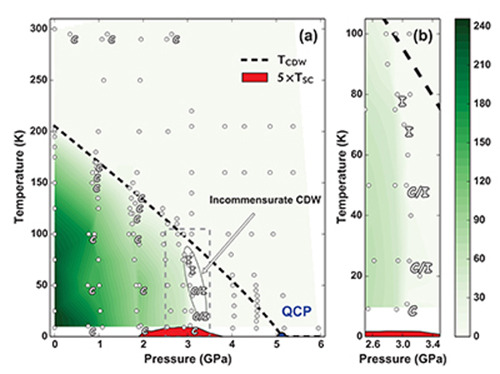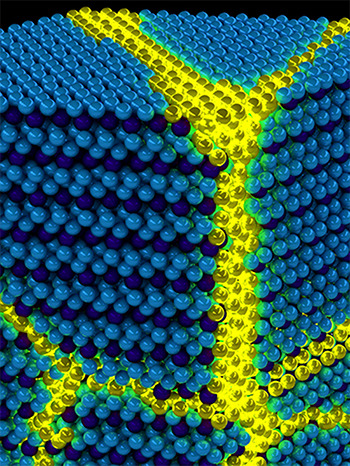18 Apr 2014

 See full article here:
See full article here:
http://www.nature.com/nphys/journal/vaop/ncurrent/full/nphys2935.html
Emerging research suggests a new paradigm for 'unconventional superconductors'
Superconductivity in so-called unconventional superconductors, for example copper-oxide, iron-arsenide and iron-selenide high-temperature superconductors, is nearly always found in the vicinity of another ordered state, such as antiferromagnetism, charge density wave (CDW), or stripe order. This suggests a fundamental connection between superconductivity and fluctuations in some other order parameter. A team of scientists led by Peter Abbamonte of University of Illinois Urbana-Champaign has reported (Nature Physics online April 6 2014) that emergence of superconductivity in the CDW system TiSe2 coincides with a quantum critical point (QCP) at which the CDW phase transition temperature goes to zero, suggesting TiSe2 exemplifies the universal phenomenon of superconductivity emerging near suppression of an ordered state. Specifically they found the QCP does not reside as predicted within the superconducting dome region (red in 1st figure) of the pressure-temperature phase diagram, but one full GPa (almost 104 atmospheres) higher in pressure. This surprising result suggests emergence of superconductivity in TiSe2 isn't associated with melting of a charge density wave, as prevailing theory holds. In fact the CDW amplitude decreases under increasing pressure, but does not disappear at zero resistance. The researchers find superconductivity in this material is likely connected with formation of domain walls between commensurate and incommensurate regions (illustrated in 2nd figure). The discovery of this new phase boundary has implications for our understanding of superconducting behavior. The experiments, performed by UIUC graduate student Young Il Joe at the Cornell High Energy Synchrotron Source (CHESS), C line, employed a novel X-ray scattering technique to observe the degree of commensurability of the CDW order parameter. They took advantage of energy harmonics in the incident beam to simultaneously measure periodicity of the crystal lattice and of the electrons. At low energies, the CDW was found to be commensurate, as expected, but above the superconducting dome, incommensurate behavior emerged as the temperature increased The superconducting characteristics of TiSe2 are typical of other unconventional superconducting materials that exhibit the universal phase diagram, suggesting a fundamental connection between unconventional superconductivity and the quantum dynamics of domain walls. This work sheds new light on our understanding of the theorized connection between superconductivity and other ordering phenomena and it could contribute to eventual development of better superconducting materials, and ultimately to the possible invention of room-temperature superconductors. The X-ray experiments were supported by the U.S. Department of Energy under Grant No. DE-FG02-06ER46285. Young Il Joe, Shi Yuan, and Lance Cooper grew the 1-!TiSe2 crystals at the Frederick Seitz Materials Research Laboratory at the University of Illinois at Urbana-Champaign with support from DOE Grant No. DE-FG02-07ER46453. Use of the CHESS was supported by the National Science Foundation and the National Institutes of Health/National Institute of General Medical Sciences under NSF award DMR-0936384. T.C. Chiang's contributions were supported by DOE Grant No. DE-FG02-07ER46383. The conclusions presented are those of the scientists and not necessarily those of the funding agencies.
Figure 1: Pressure-temperature phase diagram of TiSe2.
(a) Broad phase diagram showing CDW ordered, normal state, and superconducting phase boundaries. The green color scale indicates the integrated intensity of CDW correlations, including both C & IC components. The superconducting TSC value [reproduced from Kusmartseva, et.al. Phys. Rev. Lett. 103, 236401(2009)] has been exaggerated by a factor of 5 for visibility. Points where precise commensurability was measured are labeled C, I, or C/I, indicating commensurate, incommensurate, or coexistence, respectively. (b) Zoom-in on the region exhibiting the transition between commensurate and incommensurate order.
(a) Broad phase diagram showing CDW ordered, normal state, and superconducting phase boundaries. The green color scale indicates the integrated intensity of CDW correlations, including both C & IC components. The superconducting TSC value [reproduced from Kusmartseva, et.al. Phys. Rev. Lett. 103, 236401(2009)] has been exaggerated by a factor of 5 for visibility. Points where precise commensurability was measured are labeled C, I, or C/I, indicating commensurate, incommensurate, or coexistence, respectively. (b) Zoom-in on the region exhibiting the transition between commensurate and incommensurate order.

Image by Young Il Joe, reprinted with permission from the authors, Nature Physics, pdoi:10.1038/nphys2935. Copyright 2014 by Nature Publishing Group.
http://www.nature.com/nphys/journal/vaop/ncurrent/full/nphys2935.html
Submitted by: Ken Finkelstein, CHESS, Cornell University
04/18/2014

